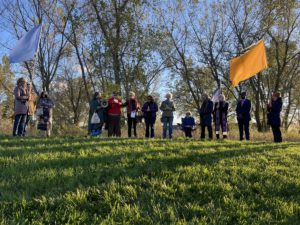Authors: Outer Harbor Coalition members and inter-faith groups
Buffalo’s Common Council recently approved a special use permit for a $13 million amphitheater on the Outer Harbor that nobody wants. A state economic development agency, the Erie Canal Harbor Development Corporation (ECHDC), is planning to relandscape a naturalizing area on the landward side of Terminal B to be a music amphitheater for up to 8,000 ticket holders—essentially Canalside moved to the Outer Harbor.
Noise, night lighting, traffic jams, overflow parking on adjacent meadows, and massive spraying to keep the bugs down are all involved in this project that developers say will benefit the birds and other wildlife currently using the site. But the coups-de-grace, the clear-cutting of hundreds of trees, only came up recently, after people went out to look at the site and saw them.
As reported in the October 13 Buffalo News, the ECHDC sees the site as “biologically bankrupt . . . everything is stagnated and can’t move forward . . . the trees to be removed are cottonwoods, black locusts . . . and opportunistic plants coming in . . . the conditions are so poor natural succession isn’t even occurring . . . There are no conditions that support a healthy habitat.”
Well, apart from blaming this post-industrial landscape for not recovering faster, what about these claims? Is there no value to the couple hundred of trees that have grown up here naturally—some quite big with others coming up eventually to replace them?
Speaking for the trees – Photo by Jay Burney
In Trees of Power: Ten Essential Arboreal Allies, arborist, author and speaker Akiva Silver names cottonwoods and black locusts (both native species) among our ten essential “arboreal allies” for ecosystem regeneration:
“Poplars (cottonwoods are the giants of this species) are some of the fastest-growing trees in the world. They can tolerate the worst conditions and are heavily favored by wildlife. In places where land has been degraded or is falling apart, poplars can rebuild. They produce tremendous amounts of biomass, feed unbelievable numbers of insects, birds, and mammals, and suck tons of carbon out of the sky.”
Hmmm. Okay, but what about that grove of black locusts over there. Aren’t they a horrible invasive species? Silver calls the black locust “the restoration tree.” “It is able to form relationships in the soil with certain bacteria that allow it to fix nitrogen right out of the atmosphere.” They are a pioneer species. “Their light shade offers protection to other species while they improve the soil through their nitrogen fixing and easily compostable leaf litter.” In late spring “honeybees as well as many other pollinating insects flock to (their) fragrant blossoms. . . Black locust is considered one of the biggest nectar flows of the season by beekeepers.”
Regenerated meadow: Photo by Jay Burney
The ECHDC approved $13 million in public funds for the amphitheater landscape re-do which the public has largely rejected for all the reasons listed above. Meanwhile, the one private property in this otherwise publicly-owned stretch of Lake Erie coast is now up for sale at $12 million. Spending our public money to secure that site as part of a protected Buffalo-Lake Erie Coastal Park is the best investment we could make in the future health of our city, our lake, its fish and wildlife, our shared waters and our people.
Lead image: Prayer vigil photo by Linda Schneekloth

